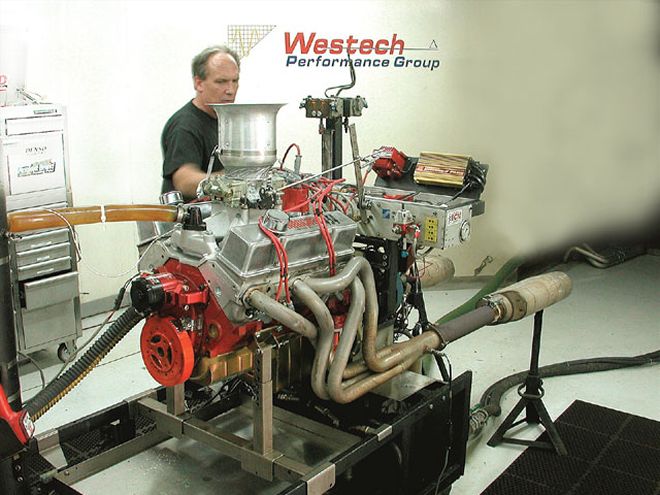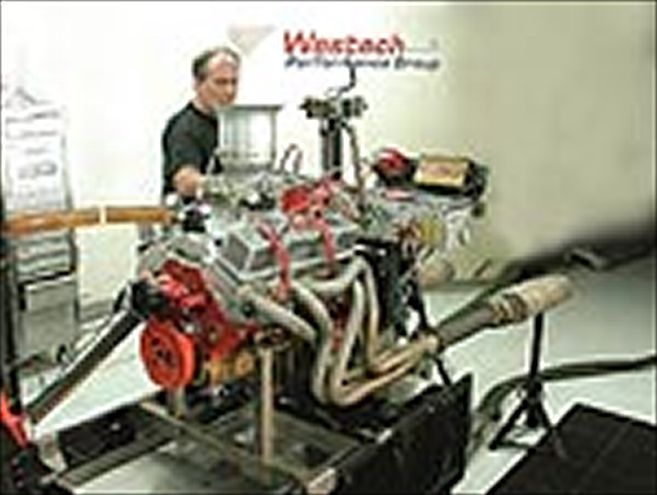


The headline could have screamed "David Slays Goliath" or perhaps "Mouse Slays Rat! Film at 11!" In our Rodent Wrestle Fest, the engine theorists were laying bets that the small-block, with its painfully smaller heads, would make great torque, but those monster rectangle port heads and sewer pipe-sized valves in the Rat motor would steamroll the little motor when it came to peak horsepower.
The combustion prognosticators were close, but surprisingly, the small-block made more power than the Rat at every point except three. Are you surprised? We were (a little) and along the way, we learned some very interesting stuff. There's far more to this story than just a same-displacement comparison with a glance at peak horsepower, peak torque, and average power numbers. Here's what we found.
Round 1In our first test, we bolted the World Products 454ci small-block up on Westech's dyno and outfitted the engine with a Holley HP-series 850-cfm carburetor, a set of 131/44-inch headers, a complete 3-inch exhaust system baffled by a pair of Flowmaster 50-series mufflers, and water circulation handled with Westech's electric water pump. This engine is actually no stranger to the pages of Car Craft nor to Westech's dyno. In fact, this same engine spent serious time in the Project SuperNova engine bay and on Westech's same dyno, making an impressive 610 hp and 584 lb-ft of torque on 91-octane pump gas.
But wait a minute! Looking at our dyno sheets, we "only" made 574 hp and 556 lb-ft of torque, so what happened? First of all, those dyno tests were performed using a much larger 1,050-cfm Dominator carburetor, while great for peak hp numbers, a 1,050 carb may not be the best for the street. More importantly, between the time that Hot Rod tested this 454 Mouse and our subsequent testing, Westech discovered its shop barometer was reading low, making the horsepower correction factor they used a bit inflated. According to Westech's dyno master Steve Brule, this was about four to five percent. Applying a 5 percent correction to 610 hp equals 580 hp-or a little more than 1 percent higher than our dyno numbers. 'Nuff said about that.
If you look at the small-block power numbers, the hefty Mouse delivers outstanding torque, over 500 lb-ft of grunt from 3,000 all the way up to 5,900 rpm! With the Crane solid-lifter flat-tappet cam, peak power occurs at 6,300 with a power band between peak torque and peak horsepower of a decent 1,600 rpm. The excellent torque is due primarily to the "small" (compared to the Rat motor's rectangle port heads) 220cc intake ports actuating 2.125-inch intake valves.
But rather than get any deeper into the small-block numbers, let's take a look at how the Rat fared.
Round 2Bolting the big-block rodent up on Westech's SuperFlow dyno, we used the same size 131/44-inch headers, the exact same MSD ignition and distributor, along with the identical 850-cfm Holley carb. After the requisite timing and jetting adjustments for peak overall power, it was time to yank the handle for the power comparison.
While most Rat fanciers won't like these results, the power numbers instantly revealed that the Rat's larger intake ports prevented the larger rodent from generating equal or better torque numbers, while we were somewhat surprised that the Rat wasn't able to make up for this at the top end. Some power pundits had offered that the larger Rat ports would support a top-end hero horsepower charge, but that didn't materialize, giving the same-sized Mouse the overall win in every category from peak and average torque, as well as peak and average horsepower.
Theories abound as to what we saw with this test, and the numbers deserve some explanation. Conventional wisdom holds that the smaller cross-sectional area of the small-block heads create a much higher inlet velocity, which is the main reason that the small-block made more torque throughout the entire rpm band compared to the Rat. The similar cam timing numbers created very similar torque and horsepower peak rpm points, even though the Rat had a valve lift advantage given its 1.7:1 rocker ratio compared to the small-block's 1.6:1 rockers.
The Rat's stronger airflow numbers might lead you to believe that it should have an advantage. While it's entirely possible that the camshaft may be optimized more for the small-block's smaller heads, another possibility is that the huge inlet ports never achieve sufficient airspeed to truly fill the cylinders. This can be backed up with evidence from older dyno tests that the late John Lingenfelter performed more than 10 years ago, making over 650 hp with a 496ci Rat using ported oval port heads with cross-sectional port areas closer to the small-block area numbers.
Despite the huge difference in head dimensions, the peak horsepower differential is a mere 7 hp and the greatest horsepower difference over the entire curve was only 12 hp. So we're not talking about monster differences here, but its worth mentioning that calculating bearing speed differences between the two engines could also be significant since the Rat motor's larger rod bearings spin 4 percent faster while the mains spin 5 percent faster than the small-block's bearings. This is simple frictional horsepower robbing the Rat, especially at higher engine speeds.
Another nail in the Rat motor's coffin is weight. Not only is the Rat motor crank heavier (perhaps as much as 15 pounds) due to the engine's greater length and girth, but everything about the big-block is, well ... big! Even on the conservative side, an aluminum-headed Rat motor weighs about 75 to 80 pounds more than a typical aluminum-head small-block. In our case, our Rat motor was equipped with anchor-like iron heads that add an easy 75 more pounds to the overall Rat weight penalty. However, these same iron heads should offer a slight improvement in power since iron heads tend to increase power slightly over aluminum, all other variables being equal.
Ironically, the Rat motor would appear to be less expensive than the $10,495 price tag that World Products currently has assigned to the 454ci small-block. Our Rat motor would run slightly less expensive at around $9,000 depending upon where you bought the parts, assuming you start with the GM Performance Parts 454 H.O. short-block.
ConclusionDespite some significant differences in port flow area, valve sizes, and rotating weight, to discover a difference of less than 10 peak horsepower and a average torque difference of 7.4 lb-ft, it doesn't take much to see that the small-block will out-perform the big-block down the quarter-mile, all other variables being equal. This may come as a bit of a shock to the Rat motor true-believers, but when it comes to the 454ci Mouse motor, it appears good things do come in small packages.
Cylinder Head Tech ChartThe following chart is port-flow cfm numbers tested on Westech's Superflow bench at a test pressure of 28 inches of water. The numbers for the big-block heads are actually from a different set of World Products heads fitted with smaller 2.250-inch intake valves. The heads used on the test 454 employed larger 2.300-inch valves that would increase flow slightly at every data point. The small-block head flow numbers are also from smaller 2.08-inch intake valves.
Small-Block Rat Motor Motown 220 Merlin VR Iron Valve Lift Intake Exhaust Intake Exhaust 0.100 58 52 79 57 0.200 132 105 158 100 0.300 195 156 216 141 0.400 244 181 258 175 0.500 274 192 292 193 0.600 277 194 313 207 Valve Sizes 2.08/1.60 2.25/1.88
Dyno Test Data Test 1: 454ci Small-Block Chevy Test 2: 454ci Big-Bock Chevy TEST 1 TEST 2 DIFFERENCE RPM Small-Block Big-Block TQ HP TQ HP TQ HP 3,000 500 286 492 281 - 8 - 5 3,100 500 295 489 289 -11 - 6 3,200 502 306 489 298 -13 - 8 3,300 504 317 492 309 -12 - 8 3,400 507 328 497 322 -10 - 6 3,500 512 341 502 334 -10 - 7 3,600 517 355 506 347 -11 - 8 3,700 521 367 510 359 -11 - 8 3,800 523 379 514 374 - 9 - 5 3,900 528 392 519 386 - 9 -6 4,000 533 406 529 403 - 4 - 3 4,100 539 421 538 420 - 1 - 1 4,200 544 435 539 431 - 5 - 4 4,300 546 448 543 444 - 3 - 4 4,400 549 460 544 456 - 5 - 4 4,500 550 472 544 466 - 6 - 6 4,600 554 485 544 477 -10 - 8
4,700 556 498 543 486 -13 -12 4,800 555 508 543 496 -12 -12 4,900 554 517 545 508 - 9 - 9 5,000 554 528 543 517 -11 -11 5,100 551 535 540 525 -11 -10 5,200 547 542 537 531 -10 -11 5,300 543 548 532 537 -11 -11 5,400 538 553 528 543 -10 -10 5,500 528 553 522 546 - 6 - 7 5,600 520 555 517 551 - 3 - 4 5,700 514 558 512 556 - 2 - 2 5,800 506 559 507 560 + 1 + 1 5,900 502 564 503 565 + 1 + 1 6,000 495 565 495 565 - - 6,100 492 572 488 567 - 4 - 5 6,200 485 573 480 567 - 5 - 6 6,300 478 574 471 565 - 7 - 9 AVG 522 471 519 455 - 7 - 6 PEAK 556 574 545 567 -11 - 7
Cross-Sectional Area Comparison: Motown 220 Small-Block: 2.145 x 1.200 = 2.57 square-inches Merlin VR Iron Big-Block: 2.250 x 1.605 = 3.61 square-inches